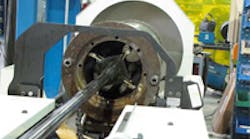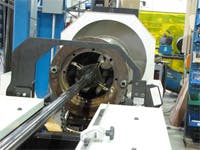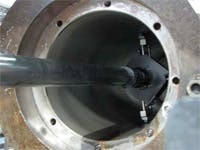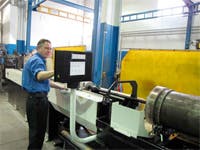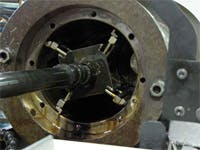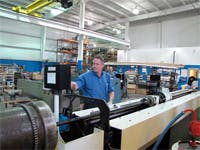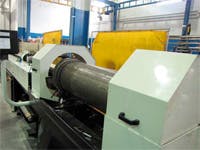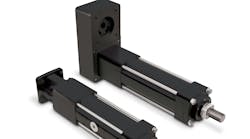In-house hydraulic cylinder honing improves efficiency and reduces costs: web exclusive
Sometimes the best way to ensure a job is done right is to do it yourself, especially when doing so adds to the bottom line and trims turnaround time. Add to this the ability to salvage damaged cylinders, a higher quality finished product and increased worker safety, and it’s no surprise why Louisville, Ky.-based Air Hydro Power acquired a Sunnen HTA horizontal tube hone to repair and recondition its own hydraulic cylinders. Adding the HTA to its repair shop’s machine tool lineup allowed Air Hydro to bring previously outsourced honing work back in-house, helping it regain control of job turnaround times and save the company thousands in outsourcing costs.
Air Hydro Power started in 1961 in its founder's basement, but quickly established itself as a major player in hydraulics in 1965 by becoming the third Vickers distributor in the U.S. The acquisition of Marlatt Controls in 1983 brought pneumatics technology into the business. In 1998 the company was purchased by its current owners, Dick Beaven, Thomas McGuire and Matthew Ott, and acquisition of Premier Hydraulic Services the same year added a repair facility now known as Air Hydro Repair Division.
When Air Hydro Power's Perry Goldstein assumed leadership of the repair division in 2007, the company’s in-house honing capability consisted of hand honing with a half-inch chuck Milwaukee drill. "Hand honing was physically demanding and a little tricky," said Goldstein, Air Hydro's Director of Value Added Services. "If someone accidentally hit the reverse switch while adjusting the hone, the stones would bite the tube and rotate the drill, which is not good if you're the one standing next to it."
Other factors, such as inability to maintain constant stone pressure and having to deal with blind bores, relegated Air Hydro's in-house honing to low-end tasks such as taking out light scratches, deglazing or polishing. "Correctly honing a tube, maintaining accurate diameter and keeping all the taper out, is really difficult to do by hand," added Goldstein. Therefore, parts requiring more significant material removal had to be sent out at significant cost. Outsourcing also took out some control of meeting delivery dates, putting Air Hydro at the mercy of its honing subcontractors.
"There were times when sending parts out-of-house came back to bite us," said Goldstein. "A third party may not have the same sense of urgency we do. We'll work all night and do everything we can to deliver parts on time, because we have ultimate accountability to our customers. Bringing the HTA on board gives us more control of projects and the ability to deliver when we promise."
The AHP repair division services and repairs all brands of industrial and mobile hydraulic pumps, motors, and valves, bust the majority of the work in the repair shop is primarily focused on refurbishing steel hydraulic cylinders used in construction equipment, material handling equipment (forklift trucks, telehandlers, and lift-gates) and heavy industry (cranes, oil rigs, off-road vehicles). Approximately 80% of AHP's repair work is done on cylinders 8 in. (203.2 mm) or smaller in diameter, however it has honing stone sets and holders that handle bores up to 18 in. (457.2 mm). "Our largest lathe has a 3-ft swing and 15-ft bed," said Goldstein. "But, most of our work is done on our 22-in. swing lathe. The HTA fits perfectly with our other equipment."
The Sunnen HTA tube honing system handles parts weighing up to 8000 lb (3629 kg) with ID ranges from 2.5 to 21 in. (63.5 to 533 mm). The HTA machine is available for 6-ft (2 m) and 12-ft (4 m) part lengths. Air Hydro Power (AHP), Louisville, a distributor and repair center for fluid powr components and systems, has a 12-ft model HTA machine. The HTA is designed for resurfacing and repair work where light-duty stock removal up to 0.030 in. (0.76 mm) is required.
AHP's HTA hone also gives the repair shop greater flexibility on how to approach a job, and has saved many cylinders from the scrap heap. "Having the hone in-house allows us to look at the size and complexity of each job and determine if it's a repair or a replacement," said Goldstein. "Prior to the HTA, we'd rub a finger over the tube and determine the material removal to be 0.005 in., which means 0.01 in. off the diameter. That would require us to make a new piston, new seals, etc., and we were better off just making a new tube."
What AHP discovered, however, is the grooves felt larger than they actually were due to the "finger test" reflecting raised material as well as missing material. "Now, we put that tube on the HTA, make a few passes and find that, once honed, the tube may be only 0.001 or 0.002 in. over tolerance and the seals can easily absorb 0.002 in., so we save the tube."
The HTA also comes in handy when AHP builds a cylinder from scratch, which requires the tube to have a trunnion mounted. When the trunnion is welded on, the cylinder will distort and cause a tight spot. AHP hones the tube to eliminate the tight spot and allow the piston to pass. The shop also hones across all ports on the tube, which improves the life of the seals and wear bands.
The HTA includes a Siemens drive and PLC-control with touch-screen HMI for setting machine parameters such as stroke reversal point, spindle/stroking speed and crosshatch angle calculation. The control features a load meter to determine areas of bore tightness, and provides the ability to dwell the tool in multiple areas to correct part geometry. A touch screen-controlled hone provides a safer working environment and reduces operator fatigue. It also provides better quality parts by producing a controlled crosshatch pattern, which allows the honed surface to retain oil or grease, ensuring proper lubrication and ring seal of pistons in cylinders. "Having an automatically stroked machine is better for our crew and better for our parts," said Goldstein.
Transition to the HTA was easy for AHP, as the machine uses the same Sunnen ANR tooling the shop was using to hand hone. The shop's crew also appreciates how fast and easy the machine is to operate vs. the old hand honing method. "Generally, it takes us longer to set the machine up than to run it," said Goldstein. "We know how much material is removed for every minute the machine runs, so we calculate the surface area and set the time. Once we get it set, we can hit the go button, walk away for a few minutes, come back and measure and we're done."
The shop will run anywhere from two to 15 parts per day through the hone. "We've got it down to where we will stage the tubes by grouping like sizes, so we can run it without changing the setup," added Goldstein.
On the business side of the equation, the HTA hone has delivered excellent return on the investment. Goldstein cited an example of a large-bore, thin-walled steel cylinder that the company had outsourced due to the complexity of the honing operation required to get the part to spec. "This part is extremely hard to hone," said Goldstein. "The manufacturer would have to make three or four parts to get one to spec, and that makes for a very expensive part."
Air Hydro developed special fixturing for the part and was able to hone it in-house with the HTA. "It took us some time to get the set up right," said Goldstein. "But, in the big picture we saved a lot of money."
The savings goes beyond eliminating third party help. "When we were looking to justify the purchase, we considered not only the elimination of outsourced work, but also warranty claims that would have been written off," said Goldstein. "We've had the machine less than a year and it's already paid for itself."
For more information call Sunnen Products Co. at (800) 325-3670 or email [email protected] .
